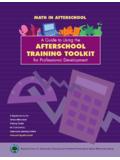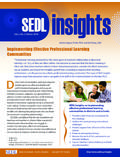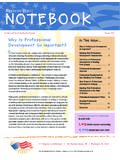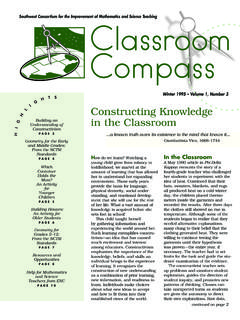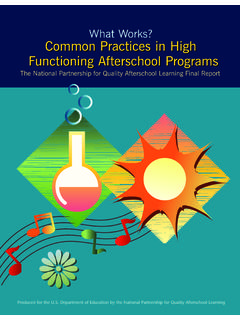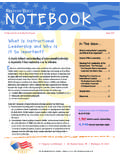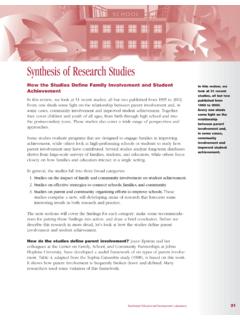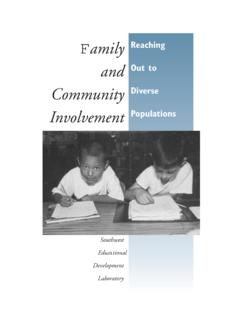Transcription of A Strategy Brief of the National Center for Family and ...
1 Southwest Educational Development Laboratory211 E. 7th St., Suite 400 Austin, Texas 78701-3253800-476-6861 Strategy Brief of the National Center for Family and Community Connections with SchoolsSeptember 2005C ontrary to the assumption of many educators, research on Family and community connections with schools has revealed that parents are interested in their children s academic success regardless of ethnicity, culture, or economic status, although they may not know how to help their children or may feel incapable of assisting them (Henderson & Mapp, 2002). Scribner and Scribner (2001) found thatParent involvement encompasses a multitude of complex phenomena. Differences in the Family structure, culture, ethnic background, social class, age and gender represent only a few of the fac-tors affecting interpretations of or generalizations about the nature of parent involvement.
2 (p. 36) This statement reflects a few of the factors that complicate and sometimes inhibit Family involvement with schools, particularly for those families representing diverse populations. In their report, Scribner et al. (2001) also say that the way a Family defines support and interest is through their own perspective. Unfortunately, many times the school s perspective and definitions of the Family involvement in school are not the same as those of the families. These dif-fering viewpoints can create barriers to meaningful participation. Schools that are successful in addressing these problems are able to build on the cultural values of families, stress personal contact with families, foster communication with families, create a warm environment for families, and facilitate accommodations for Family involvement, including transportation, translators, and other similar services (Henderson & Mapp, 2002; Boethel, 2003).
3 As illustrated in the Classroom Snapshot (page 2), teachers like Mr. Han who proactively reach out to parents rather than wait for them to come to the school are often successful in their efforts to foster effective Family and community involvement in student Out to Diverse Populations:What Can Schools Do to Foster Family -School Connections?By Chris Ferguson2 S O U T H W E S T E D U C A T I O N A L D E V E L O P M E N T L A B O R A T O R Y A Strategy Brief of the National Center for Family and Community Connections with SchoolsSeptember 2005Mr. Han is in his first year of teaching and has chosen to work in a high-poverty community in the Southwest that has a high percentage of Hispanic and American Indian students. He has been assigned to teach sixth grade science to 125 Mr.
4 Han graduated from an innovative and well-respected teacher preparation program, he wor-ries that he is not prepared to meet or understand his students needs. He knows that a common con-cern in many schools in the United States is that the ethnicity and culture of the students rarely matches the teachers. In his case, he and his parents were born in the United States, but his grandparents emi-grated from Asia as teenagers. His Family has always observed the culture of his grandparents native country as they assimilated into their new country. While he is not White, he is still different from his Hispanic and American Indian recommended in his teacher preparation pro-gram, Mr. Han has created a letter to send home to parents communicating the way he plans to con-duct his class, explaining his grading procedures and inviting them to visit his class to observe his teaching.
5 He wants the families to know that they have a stake in and can make a contribution to their children s education. Each week, he plans to send an announcement communicating the topics to be cov-ered in classes and assignment due dates. As he is photocopying this letter, one of the more experienced teachers, Mr. Atkins, asks him what he is doing. After listening to his explanation, Mr. Atkins tells him that inviting the families to school could lead to big problems. He also adds that because many of the parents of his students are not likely to be able to read the letter or will ignore it if they can read, sending the letter is useless. Shocked, Mr. Han asks what kinds of problems can come from contacting families. Mr. Atkins replies that the school staff have always felt that the less contact families have with the school, the better.
6 The idea is to keep them happy and keep them distant. Mr. Atkins goes on to say that there is no pleasing par-ents and families anyway, so it s best to avoid them. Mr. Han stands with his copies in hand for a few moments and reflects on what he has just been told. It is in conflict with what he learned in college about best practices and the possible benefits of Family and community connections with schools, but he doesn t want to be at odds with the other teachers. He takes a few moments to think about the possible consequences of going ahead and contacting the parents. Though he feels torn between what he has been taught and the cautioning words of an experi-enced teacher, he decides to continue with this , Mr. Han feels that Mr. Atkins might have a point about whether the families can or will pay attention to the letter.
7 He has had little experience with either the Hispanic or American Indian cultures. If he was in his home community, he would go through one of the neighborhood elders to reach out to the families. He isn t sure what is appropriate for the families of his students. He decides to let his students help him determine the best way to get their parents to read the introducing himself to his students on the first day of class, Mr. Han tells them that he wants their help on something. He explains that he has a letter to send home to their parents and asks the students for their help getting it to first, the students resist, saying their parents don t need this information. Typical of adolescents, they say they don t want their parents involved in school.
8 They aren t babies. However, Mr. Han points out to the students that their families will probably ask them for this information anyway, so they might as well work with him to plan a way to communicate with their families. After more discussion and some careful encouragement from Mr. Han, the students decide to help him. He repeats this process in each of his classes. Each time, the students resist, say their parents aren t interested, but then, after more discussion and encouragement, agree to help. Mr. Han says that there are always parents in a com-munity that don t read, don t read very well, or pos-sibly don t read English. He asks if this is true in this community? His students answer C H O O L S N A P S H O TS O U T H W E S T E D U C A T I O N A L D E V E L O P M E N T L A B O R A T O R Y 3A Strategy Brief of the National Center for Family and Community Connections with SchoolsSeptember 2005He then asks the students what they would do to get this information out to the families?
9 After much discussion, Mr. Han decides that he will get out of the school and onto the families turf by 1. Visiting the reservation of the American Indian students on Saturday: It is market day, so nearly everyone in the community will be in one place. Several students have volunteered to help him connect with the families of his stu-dents. The students also share that there is not a written language for their tribe. While Mr. Han can still give the Family members the letters, he will need to explain everything as well. The stu-dents don t feel that a translator will be needed, but they will help out if any parents aren t able to communicate in English. 2. Going to see the Hispanic families in their neighborhoods over the next week: Five students volunteer to be his guides and trans-lators.
10 One of the students says his mother translates documents for her boss at work. Mr. Han says he will call her at home tonight and see if she can help translate the letter so that he will have both English and Spanish , while talking to Mrs. Rand, another teacher with only a couple of years of experience, about this effort, Mr. Han realizes there is a vast difference in what he learned about Family involvement in his teacher prepa-ration program and the reality of making this happen in the school community. He certainly hadn t been pre-pared for Mr. Atkins reaction. He had thought since experts said this kind of action would prove beneficial, it would happen almost automatically. He also had no idea that his students would actually be the key to contacting the Rand is so impressed with his efforts that she wants to accompany him on his visits, as they teach many of the same students.
